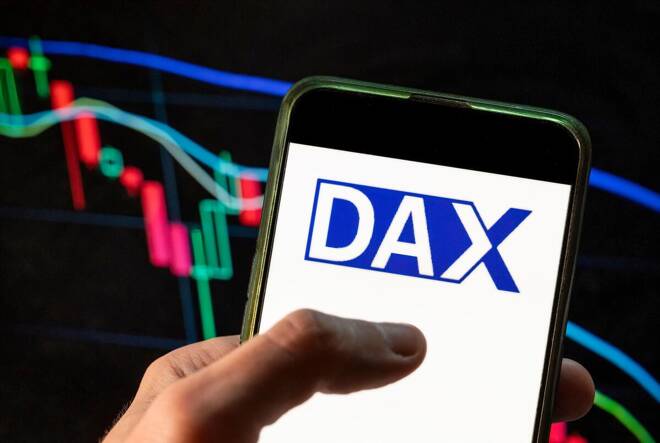Advertisement
Advertisement
DAX Index Today: Assessing Market Response to FOMC Decision and US Economic Data
By:
Key Points:
- The DAX slid by 1.03% on Tuesday (April 30), ending the session at 17,932.
- On Thursday (May 2), investors will react to the FOMC interest rate decision and press conference.
- Finalized manufacturing PMIs, US economic data, and corporate earnings also need consideration.
In this article:
The Overview of the DAX Performance
The DAX slid by 1.03% on Tuesday (April 30). Following a 0.24% loss on Monday (April 29), the DAX ended April down 3.03% to 17,932.
German Retail Sales, Unemployment, and GDP Numbers
German retail sales and unemployment figures sent mixed signals on Tuesday (April 30). Retail sales jumped by 1.8% in March after sliding by 1.9% in February. However, unemployment increased from 2.719 million to 2.732 million in April, signaling a likely pullback in consumption.
Nevertheless, the GDP numbers for Q1 supported investor expectations of an improving macroeconomic environment. The German economy expanded by 0.2% in Q1 2024 after contracting by 0.5% in Q4 2023.
Economic indicators for the Eurozone also warranted investor interest amidst rising bets on a June ECB rate cut. The Eurozone economy grew by 0.3% in Q1 2024 after stalling in Q4 2023. Furthermore, the annual core inflation rate eased from 2.9% to 2.7% in April. The numbers beat forecasts, testing buyer demand for DAX-listed stocks.
US Employment Costs and Consumer Confidence
On Tuesday (April 30), US employment cost – wages impacted investor bets on a September Fed rate cut. Employment cost – wages increased by 1.1% quarter-on-quarter in Q1 2024. In Q4 2023, wages increased by 1.1%, upwardly revised from 0.9%.
The hotter-than-expected wage figures overshadowed a larger-than-expected fall in consumer confidence. In April, the CB Consumer Confidence Index slid from 103.1 to 97.0.
According to the CME FedWatch Tool, the probability of the Fed leaving interest rates unchanged in September rose from 42.5% to 53.3% on April 30.
On Tuesday, the Nasdaq Composite Index slid by 2.04%. The Dow and the S&P 500 saw losses of 1.49% and 1.58%, respectively.
The Tuesday Market Movers
Auto stocks had a negative Tuesday session. Mercedes Benz Group and Volkswagen slid by 5.15% and 4.54%, respectively. The automakers reported falling profits, impacting demand for auto stocks.
Daimler Truck Holdings and BMW ended the session down 4.36% and 4.07%, respectively. Porsche fell by 2.70%.
Adidas fell by 2.54% despite better-than-expected earnings results.
In contrast, Vonovia rallied 3.94% after reporting a return to profit.
German and Eurozone Manufacturing in Focus
On Thursday (May 2), finalized Manufacturing PMI numbers for Germany and the Eurozone will draw investor interest.
According to the preliminary PMI numbers, the German Manufacturing PMI increased from 41.9 to 42.2 in April. However, the Eurozone Manufacturing PMI declined from 46.1 to 45.6.
While the PMIs will draw investor interest, the overnight FOMC press conference will likely impact the DAX more.
Fed Chair Powell highlighted the lack of progress toward bringing inflation to the 2% target. Powell’s comments aligned with market expectations of a higher-for-longer Fed rate path. Nevertheless, Powell poured cold water over speculation about a Fed interest rate hike.
The US equity markets responded to Fed Chair Powell’s comments. On Wednesday (May 1), the Dow rose by 0.23%. The Nasdaq Composite Index and S&P 500 fell by 0.33% and 0.34%, respectively.
US Nonfarm Productivity, Unit Labor Costs, and Initial Jobless Claims in Focus
Later in the Thursday session, US labor market data will warrant investor attention. Economists forecast nonfarm productivity to advance by 0.8% quarter-on-quarter in Q1 2024 after rising by 3.2% in Q4 2023. Moreover, economists expect unit labor costs to increase by 3.3% in Q1 2024 after rising by 0.4% in Q4 2023.
Furthermore, economists predict initial jobless claims to increase from 207k to 212k in the week ending April 27.
Other stats include trade data and factory orders. However, these will likely play second fiddle to the labor market data as the market focus shifts to the US Jobs Report.
Near-Term Outlook
Near-term trends for the DAX will hinge on investor expectations of ECB rate cuts beyond June and corporate earnings. However, US labor market data also needs consideration following the FOMC press conference.
On the Futures markets, the DAX was down 5 points, while the Nasdaq mini increased by 101 points.
DAX Technical Indicators
Daily Chart
The DAX hovered above the 50-day and 200-day EMAs, affirming the bullish price signals.
A DAX breakout from 18,000 would support a move to the 18,350 handle.
The FOMC press conference, corporate earnings, and US labor market data need consideration.
However, a DAX break below the 50-day EMA could signal a potential drop to the 17,615 support level.
The 14-day RSI at 48.30 indicates a DAX drop to the 17,615 support level before entering oversold territory.
4-Hourly Chart
The DAX sat below the 50-day EMA while holding above the 200-day EMA, sending bearish near-term but bullish longer-term price signals.
A DAX break above the 50-day EMA would support a move toward the 18,350 handle.
Conversely, a DAX fall through the 17,800 handle would bring the 200-day EMA and the 17,615 support level into play.
The 14-period 4-hour RSI at 43.56 indicates a DAX fall to the 200-day EMA before entering oversold territory.
About the Author
Bob Masonauthor
With over 20 years of experience in the finance industry, Bob has been managing regional teams across Europe and Asia and focusing on analytics across both corporate and financial institutions. Currently he is covering developments relating to the financial markets, including currencies, commodities, alternative asset classes, and global equities.
Did you find this article useful?
Latest news and analysis
Advertisement
